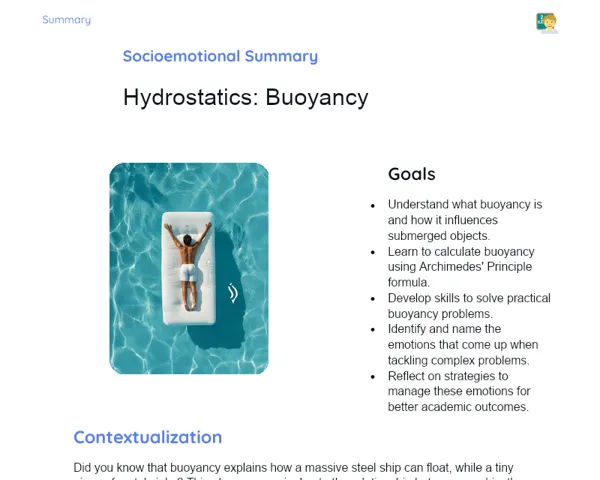Socioemotional Summary Conclusion
Goals
1. 🌟 Understand Gauss's Law and how it applies in electric fields.
2. 💡 Solve practical problems using Gauss's Law.
3. 🔍 Calculate electric flux through surfaces, applying what you’ve learned.
Contextualization
Did you know that electricity not only keeps the lights on but also powers our favourite gadgets and enables global conversations? Understanding concepts like electric field and Gauss's Law helps us see how these fantastic technologies work. Get ready for a journey where physics and emotions come together to unravel the mysteries of electricity! ⚡🤖
Exercising Your Knowledge
Electric Field
An electric field is a region around an electric charge in which another electric charge would feel a force. This concept is vital for understanding how charges interact in space, creating forces that can act on other charges. Simply put, think of it as an 'invisible aura' surrounding a charge that affects nearby charges.
-
🔍 Electric Field Intensity (E): The intensity is calculated using the formula E = F/q, where F is the electric force and q is the test charge. This means that the intensity of the electric field depends on the force experienced by a charge placed in the field.
-
🤖 Direction of the Electric Field: Electric field lines originate from positive charges and terminate at negative charges. The direction these lines point indicates where a positive charge would head if placed in the field.
-
🌍 Importance of the Electric Field: Grasping the electric field is essential for tackling many physics problems and understanding electrical phenomena in our everyday lives, from how our electronics work to natural events like lightning.
Gauss's Law
Gauss's Law is a powerful principle in physics that connects the electric flux through a closed surface to the total electric charge contained within that surface. It's expressed as Φ = ∫E·dA = Q_in/ε₀. This law is particularly handy for solving problems involving symmetric charge distributions.
-
📜 Electric Flux (Φ): Electric flux quantifies how much electric field passes through a surface. It's helpful for understanding how charges interact within a closed space.
-
🔒 Closed Surface: Gauss's Law is applied to closed surfaces, like spheres or cylinders, where calculating electric flux is more straightforward due to symmetry.
-
⚖️ Symmetry and Simplification: The beauty of Gauss's Law is that it simplifies calculations in highly symmetric systems (spherical, cylindrical, planar), making it much easier to solve problems that would otherwise be quite complex.
Electric Flux
Electric flux measures the quantity of electric field passing through a surface. Its general formula is Φ = E·A·cos(θ), where θ is the angle between the electric field and the normal to the surface. This concept is crucial for understanding Gauss's Law and the interaction of electric fields with surfaces.
-
🧮 Definition of Electric Flux: Electric flux is calculated as the product of the electric field and the area of the surface, taking into account the angle between the field and the surface. This helps us quantify how the electric field interacts with that surface.
-
👩🔧 Practical Applications: It can be used to determine electric field intensity in various situations, such as charges on curved or flat surfaces, which is important when designing electronic devices.
-
💭 Connection with Gauss's Law: The idea of electric flux is directly tied to Gauss's Law, which connects the flux through a closed surface to the total charge contained within that surface.
Key Terms
-
Electric Field: The area surrounding a charge where another charge would feel a force.
-
Gauss's Law: Relates the electric flux through a closed surface to the total charge within that surface.
-
Electric Flux: The amount of electric field that passes through a surface, calculated as E·A·cos(θ).
-
Electric Field Intensity (E): Force per unit charge, E = F/q.
-
Closed Surface: A surface that completely encloses a volume, applicable in Gauss's Law.
For Reflection
-
🧠 How did you feel when tackling a tricky problem about Gauss's Law? What emotions came up, and how did you manage them?
-
🤔 How can understanding Gauss’s Law be useful in practical day-to-day situations? Can you think of a few examples?
-
🌟 How can you use the concepts of electric field and Gauss's Law to develop valuable skills like patience and resilience? Share some examples of challenging situations and how you'd navigate them.
Important Conclusions
-
✨ Understanding the electric field is crucial to unravelling how electric charges interact and create forces.
-
⚡ Gauss's Law is a driving force that allows us to calculate the electric field in symmetric situations, making it easier to tackle complex problems.
-
📊 Electric flux measures the amount of electric field passing through a surface and is essential for applying Gauss's Law in practical applications.
Impacts on Society
Electricity is woven into the fabric of our lives, from flicking on a switch to charging up our phones. By understanding concepts like electric field and Gauss's Law, we can get a better grasp of these technologies and even create innovative solutions. Picture developing a new gadget based on principles you already know – that’s not just learning; it’s transformation! 💡🚀
Moreover, diving into these concepts equips us with crucial skills like critical thinking and resilience. Confronting and solving tough mathematical challenges prepares us for real-life hurdles, where patience and perseverance are key. These emotional competencies serve us not only in school but in every aspect of our lives. 🌌🤖
Dealing with Emotions
To handle your emotions when grappling with tough concepts like electric field and Gauss's Law, let’s use the RULER method. Firstly, take a moment to Recognise your feelings while studying: Frustrated? Anxious? Excited? Next, try to Understand the reason behind those feelings. Is it because the material is challenging or because you're racing against the clock? Accurately name your emotions; for instance, 'I feel frustrated because I’m struggling with Gauss's Law.' Now, Expr express that emotion in a constructive way—this could mean journaling or chatting with a classmate. Finally, Regulate your emotions. If you’re feeling anxious, maybe some deep breathing exercises can do the trick. Practise this technique and see how it boosts your ability to tackle complex topics!
Study Tips
-
🗂️ Get Organized: Grab a planner or diary to jot down important dates and break study topics into bite-sized pieces.
-
🔄 Review Regularly: Conduct short and frequent reviews of the material, as this reinforces your knowledge and helps identify questions before the exam.
-
🗣️ Teach Someone Else: Explaining what you’ve learned to someone else is an excellent way to solidify your own understanding. Use relatable examples to clarify your explanations.



